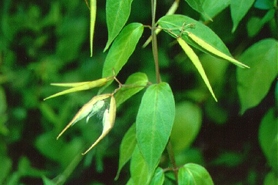Pale swallow-wort
(Vincetoxicum rossicum)
Herbaceous, perennial vine that twines three to six feet tall with small hairs on the stems and spreads vegetatively and reproductively. Dies back in the winter.
Other names for this plant include:
- Common names: European swallow-wort
- Scientific names: Cynanchum rossicum; C. medium; V. medium
Classification in Wisconsin: Prohibited
- Ecological Threat
-
- Invades the understory of forests, woodland edges, grasslands and old fields covering native vegetation and forming dense thickets. Tolerant of sun and shade.
- Allelopathic.
- Identification
-
Leaves: Opposite, oval and smooth. Dark green and shiny with pointed tips and short petioles; two to five inches long.
Flowers: Pale swallow-wort has maroon to pale pink flowers and petals that are twice as long as wide and are hairless. Umbel-like, branched clusters have six to 10 flowers that bloom June-July.
Fruits & seeds: Slender pods, similar to milkweed, are two to three inches long, form late July-August and turn from green to light brown or golden as they mature. Seeds are flat and attached to thin filaments that aid in wind dispersal, similar to milkweed.
Roots: Root crown fragments support dormant pale swallow-wort buds that resprout if not damaged. It does not have rhizomes; creeping perennial roots.
Similar species: Black swallow-wort (Vincetoxicum nigrum; invasive) is very much the same with the exception of the flowers. Black swallow-wort has dark purple flowers with petals that are the same length on all sides and are hairy.
- Distribution
-
Currently, there have been no reports of pale swallow-wort in Wisconsin. Have you seen it? Send us a report.
- Control
-
If the entire infestation cannot be treated focus on plants that are growing in the sun because they produce many more seeds than plants in the shade.
Mechanical: Remove all seed pods before they open and either burn or dispose of in a landfill; most effective if done in mid-July. If plants are dug up, all root fragments and root crown must be removed before seeds ripen.
Chemical: Cut-stem treatment with glyphosate. Foliar spray or wicking in August-September with either triclopyr ester or glyphosate and a surfactant after the infestation is mowed and new growth has formed. Foliar treatment should begin after flowering but before seed production.
- Resources
- Sources for content:
- Czarapata, Elizabeth; Invasive Plants of the Upper Midwest: an illustrated guide to their identification and control. University of Wisconsin Press. 2005. Pg. 132-133
- Plant Conservation Alliance's Alien Plant Working Group. Weeds Gone Wild: Alien Plant Invaders of Natural Areas. Pale Swallow-wort [exit DNR]



